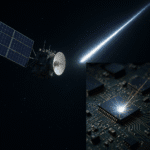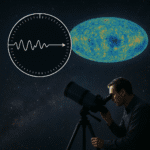Spacecraft operating beyond Earth’s atmosphere face a relentless barrage of high-energy particles known as cosmic rays. These particles originate from various sources in the universe and can penetrate spacecraft hulls, posing significant challenges to onboard electronics. Understanding how cosmic rays interact with sensitive components is critical for mission success, satellite longevity, and crew safety in manned exploration missions. This article explores the origins of cosmic rays, their interaction mechanisms with electronic systems, and the design strategies engineers employ to enhance system reliability.
Sources and Characteristics of Cosmic Rays
Cosmic rays are high-energy particles that travel through space at near-light speeds. They are typically protons (about 90%), alpha particles (helium nuclei, about 9%), and heavier nuclei (about 1%). These particles originate from three main sources:
- Galactic cosmic rays (GCRs): Emitted by supernovae and other high-energy astrophysical events in our galaxy.
- Solar energetic particles (SEPs): Produced by solar flares and coronal mass ejections within our Solar System.
- Extra-galactic cosmic rays: Rare, ultra-high-energy particles from beyond the Milky Way.
The energy spectrum of cosmic rays spans several orders of magnitude, from a few million electronvolts (MeV) to beyond 1020 electronvolts (eV). When these high-energy particles collide with spacecraft materials, they generate secondary particles, such as neutrons, electrons, and pions, which can further interact with internal components.
Interaction Mechanisms with Spacecraft Microchips
When cosmic ray particles traverse electronic components, they deposit energy along their tracks. This energy deposition can lead to various types of damage and functional anomalies:
- Single Event Upset (SEU): A transient change of state in a memory cell or register, causing bit flips without permanent damage.
- Single Event Latchup (SEL): A parasitic conduction path is triggered in a semiconductor device, potentially leading to destructive current surges.
- Single Event Burnout (SEB) and Single Event Gate Rupture (SEGR): Catastrophic failures in power transistors due to high-energy particle strikes.
- Total Ionizing Dose (TID): Accumulated ionization over time, degrading the performance of oxides and insulators in microelectronic devices.
- Displacement Damage Dose (DDD): Non-ionizing energy loss that displaces atoms in the crystal lattice, degrading semiconductor properties.
These effects can manifest as spontaneous resets, data corruption, logic misbehavior, and complete system failure. Electronic architectures in space must account for these mechanisms to maintain functionality under constant radiation exposure.
Design Strategies for Radiation Hardening
To mitigate the risks posed by cosmic rays, engineers employ multiple strategies during the design phase of spacecraft electronics:
- Material Selection: Using silicon-on-insulator (SOI) or hardened silicon processes reduces sensitive volume and limits charge collection.
- Redundant Systems: Implementing triple modular redundancy (TMR) ensures that a single upset in one module can be outvoted by the correct outputs of two other modules.
- Error Detection and Correction (EDAC): Built-in algorithms detect and correct bit flips in memory, preventing data corruption from manifesting at higher system levels.
- Shielding and Structural Design: Strategically placing high-density materials like aluminum or polyethylene can attenuate the flux of secondary particles.
- Power Supply Protections: Current limiting, monitoring, and automatic shutoff circuits to prevent destructive latchups.
Each approach carries trade-offs in terms of mass, power consumption, and cost. Effective system design balances these factors against mission requirements and acceptable failure rates.
Testing and Validation Procedures
Ground-based testing is essential to validate the robustness of spacecraft components under simulated cosmic ray bombardment:
- Particle Accelerator Facilities: Proton and heavy-ion beams recreate the energy spectra of GCRs and SEPs, enabling targeted testing of single event effects.
- Gamma and X-ray Sources: Used to simulate cumulative TID effects over extended mission durations.
- Neutron Generators: Assess displacement damage in specific semiconductor processes.
- High-altitude Balloon Flights: Provide near-space environments for integrated system testing of cubesats and small satellites.
Test results feed into reliability models that estimate mission lifetime and failure probabilities, guiding design adjustments and operational protocols.
In-orbit Incidents and Anomalies
Several high-profile spacecraft missions have experienced electronic anomalies attributed to cosmic rays:
- Hubble Space Telescope: Encountered memory errors and single event upsets requiring periodic resets of onboard computers.
- SOHO (Solar and Heliospheric Observatory): Experienced several safe-mode entries caused by solar energetic particles.
- Galileo Probe: Recorded sensor glitches and corrupted telemetry during flybys of Jupiter’s intense radiation belts.
- Commercial Satellite Constellations: Ongoing monitoring has revealed bit-flips in communication payloads, occasionally degrading data throughput.
Failure investigations consistently highlight the importance of robust mitigation measures and continuous monitoring of space weather forecasts to anticipate periods of elevated particle activity.
Advances in Protective Technologies
Recent research focuses on novel materials and architectures to further shield and protect spacecraft electronics from cosmic rays:
- Electrostatic Deflection Systems: Use localized electric fields to steer charged particles away from sensitive zones.
- Advanced Composite Shielding: Hybrid panels combining hydrogen-rich polymers with metal layers for enhanced neutron attenuation.
- Radiation-tolerant Field Programmable Gate Arrays (FPGAs): Incorporate hardened logic blocks and dynamic reconfiguration to recover from upsets.
- Machine Learning-based Diagnostics: Predict and isolate fault conditions in real time, enabling autonomous reconfiguration and recovery.
These innovations promise to improve the reliability and longevity of future missions, particularly those venturing into deep space or into the intense radiation environments of outer planets.










